Implantology is now a widely used clinical technique in dentistry. Its purpose is to resolve the absence of natural dental elements with the insertion of fixed prostheses. During the operation, titanium screws (fixtures) are inserted into the patient’s jawbone. These serve as a root to support the artificial crown.
This restores masticatory function and the best smile. In addition, this solution is distinguished by a high success rate for ten to fifteen years. Our dental clinic specializes in the creation of dental implants in Milan. We remain constantly updated on the main alternative procedures, including Computer-Assisted Implantology, Flapless, immediate loading, All On Four, All On Six, and Toronto Bridge.
To schedule a preliminary visit, contact our practice.
Dental implantology is the set of surgical techniques that aim to rehabilitate a patient’s masticatory function, using dental implants, i.e. artificial pillars which, once integrated into the bone, will be able to support one or more artificial teeth.
The dental implant replaces and totally replaces the lost tooth both from an aesthetic and functional point of view. The total time, in traditional implantology, for implant-prosthetic rehabilitation ranges from 3 months to 6 months, depending on the clinical case.
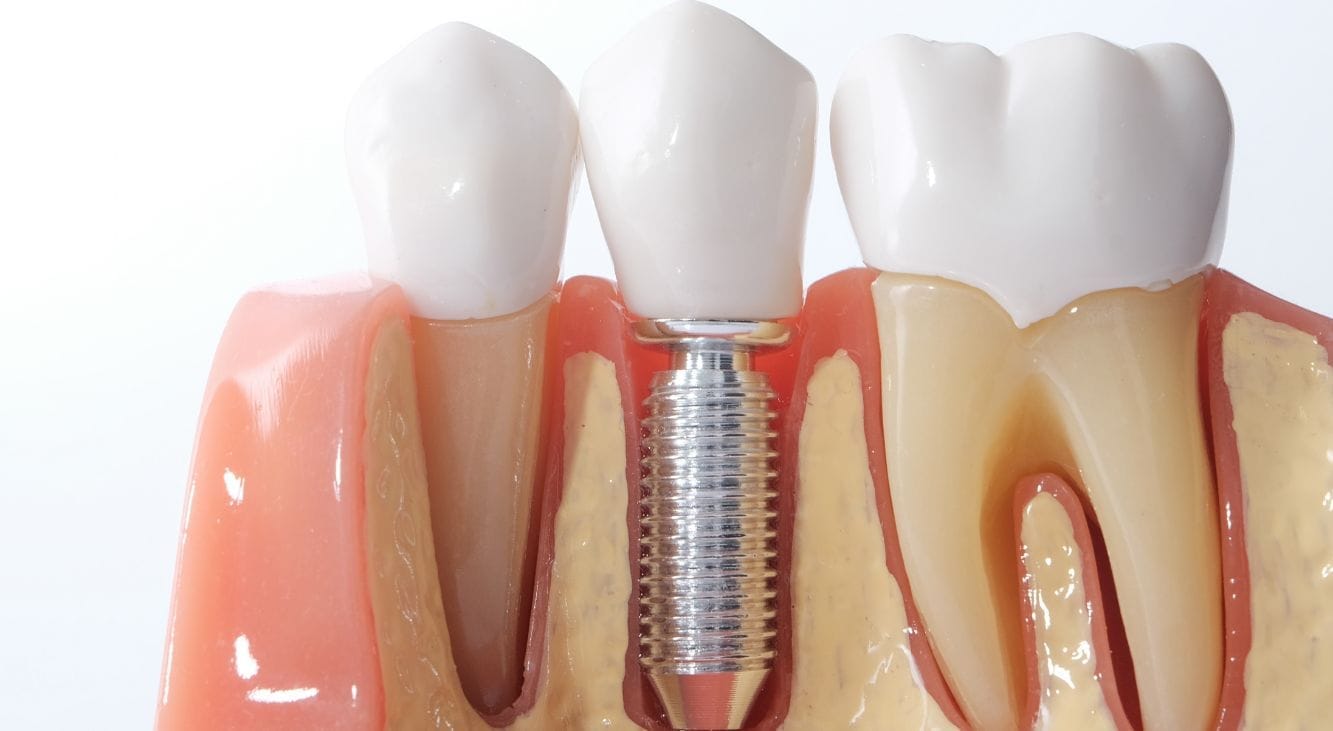
In this type of implant technique, if the clinical case allows it, it is possible to extract the compromised dental elements and simultaneously insert the corresponding dental implant.
This reduces the number of surgeries required and therefore also the number of medications taken by the patient and also halves the time to finalize the treatment plan.
Of course, together with a post-extractive dental implantology, the immediate loading implantology technique can also be combined.
In the case of post-extractive implantology, if the clinical case allows it, it is possible to extract the compromised dental elements and simultaneously insert the corresponding dental implant.
In a single intervetion, therefore, the extraction is carried out and the dental implant is placed. In this way it will not be necessary to carry out two different interventions.
The main moments of the post-extraction implant insertion technique are:
STEP 1: Tooth extraction, paying attention to leave the alveolus intact.
STEP 2: Cleaning of the alveolus and preparation for implant insertion
STEP 3: Implant insertion.
The success rate of post-extraction implantology is equal to that of traditional implantology.
We have specialized, for some time now, in the creation of dental implants in Milan, with the immediate loading technique. This technique allows us to insert titanium pins and, during the same session, place a semi-permanent fixed prosthesis (temporary, in resin). In this way, the patient will not have to face the long period that lies between the implanted graft and the placement of the crown.
The implant, or implants, are positioned in the morning, and in the afternoon a temporary fixed prosthesis will be screwed into the patient’s mouth.
For immediate loading to be performed, certain conditions are necessary. Among these: sufficient torque (physical resistance to the screwing of the implant, measured with a torque wrench) of at least 35 NW; adequate bone density which will be assessed with a Cone Bean CT scan present in our clinic.
Thanks to the computer planning of the entire operation, computer-assisted implantology allows you to drill the gum and the bone without opening any flap.
An effective treatment option, specifically indicated in patients with bone, jaw, and mandibular atrophy. Replaces missing teeth with a complete restoration that is fixed with only four dental implants, two straight central and parallel ones, and two more inclined outer ones. This solution makes treatment simpler and reduces the need for more invasive procedures, such as those to increase bone volume.
Advantages:
Obtaining a fixed full-arch prosthesis on the day of the surgical intervention quickly leads to an improvement in patient satisfaction in terms of functionality, aesthetics, perception, phonation, and self-esteem.
The inclination of the posterior implants avoids the need for long procedures for bone grafting, while immediate loading abbreviates the treatment times.
The concept is less expensive than the conventional treatment modes of edentulous and near-edentulous arches.
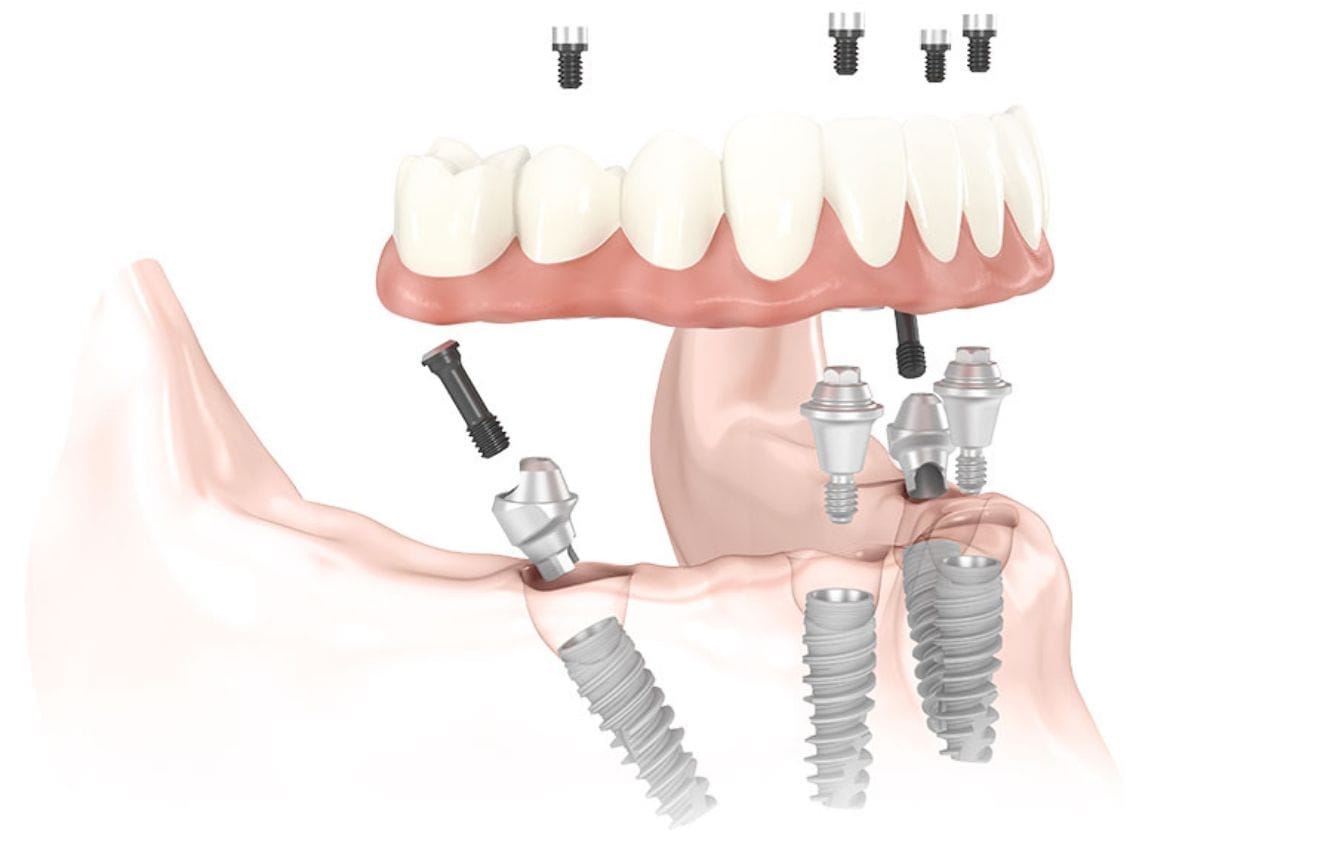
Mainly developed for the upper arch, the All-On-Six technique involves the placement of six implants, two of which are angled (the outer ones) to avoid invasion of the maxillary sinuses. This allows the implants to be immediately loaded with a fixed temporary resin bridge of twelve elements (immediate load).
This procedure can also be computer-planned and performed with guided surgery when conditions permit (computer-guided implantology).
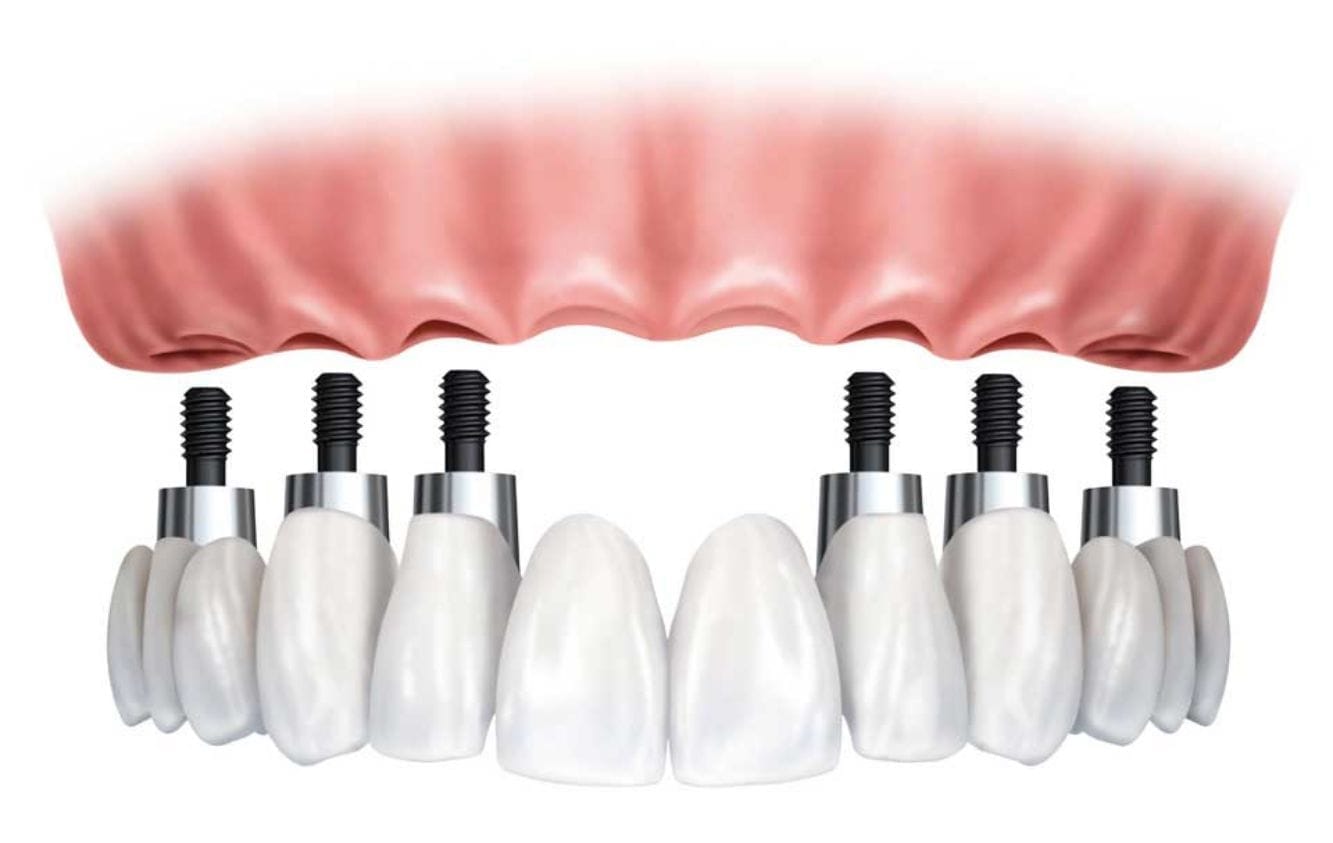
Toronto Bridge refers to a fixed prosthesis screwed onto four or six straight dental implants that can replace up to 12-14 teeth. The main advantages of this technique are many: it is the ideal solution in case of total tooth loss; it is more economical compared to other techniques; the operation can be completed within 12/48 hours; the procedure is minimally invasive and has reduced healing times.

Thanks to the computer planning of the entire procedure, computer-assisted implantology allows for the drilling of the gums and bone without opening any flaps. In other words, the operation does not require cutting of the mucosa to access the underlying bone planes. Therefore, no sutures will be necessary and there will be no swelling or other post-surgical discomforts. The procedure has reduced times compared to the traditional technique. Above all, it allows rehabilitation of patients who, due to systemic diseases (diabetes, coagulopathies, reduction of immune defenses), could not undergo a too-invasive intervention. In the same way, this procedure has proven to be extremely valid in the case of subjects with odontophobia.
What are the benefits?
Also known as transmucosal implantology, the Flapless technique dramatically reduces healing times and is particularly indicated for patients suffering from systemic diseases. During the procedure, holes are made in the gums that have an adequate diameter for implant insertion. This avoids exposing the bone and, therefore, limits the risk of any physiological resorption after surgical exposure. As mentioned, shorter healing times follow.
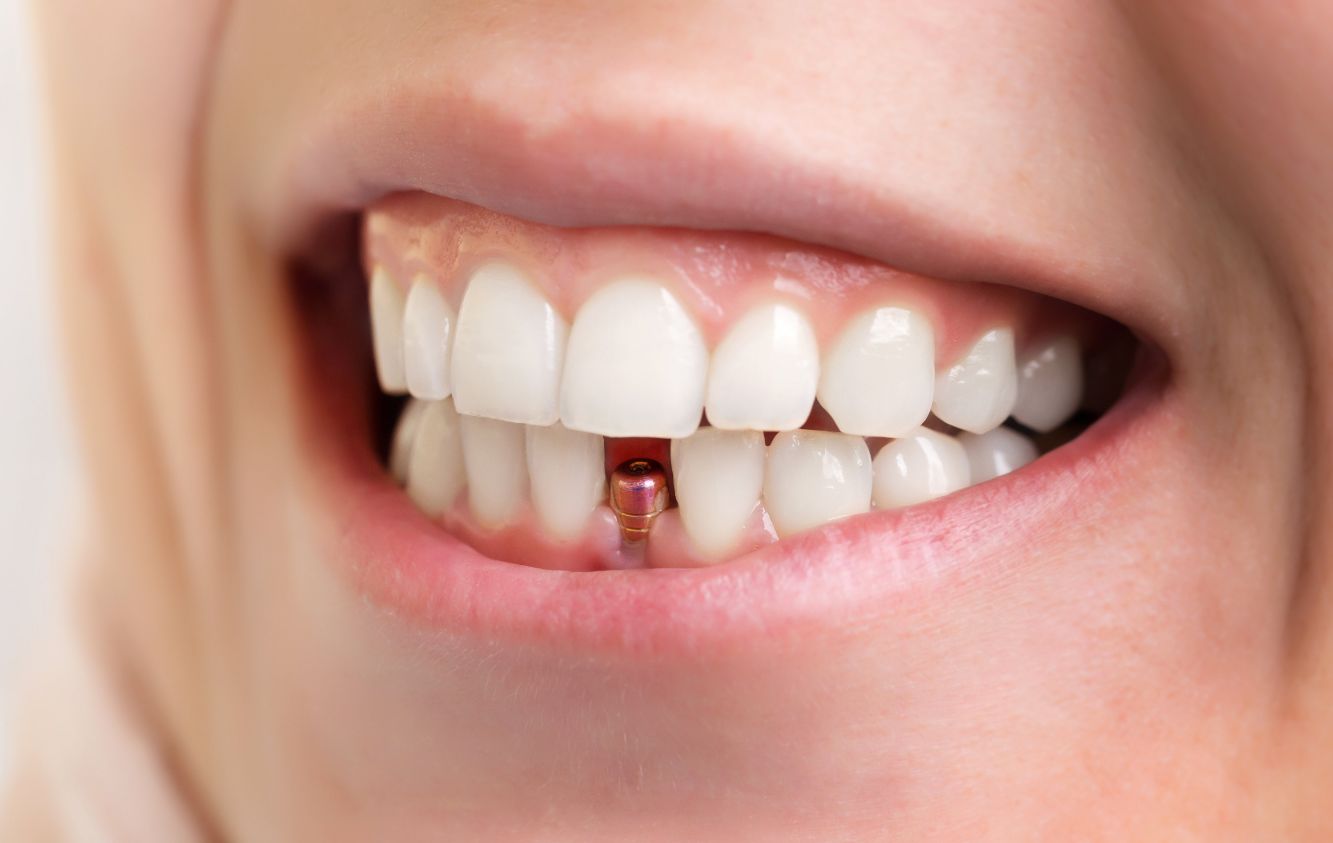
Overdenture prostheses on bar-anchored implants replace an entire dental arch with a dental prosthesis similar to a removable denture but anchored to a metal bar that is in turn fixed to implants anchored to the mandibular or mandibular or maxillary bone tissue.
Locator attachments offer excellent performance for the application of overdenture on dental implants. Rehabilitation with Overdenture on two dental implants is suitable for edentulous patients.
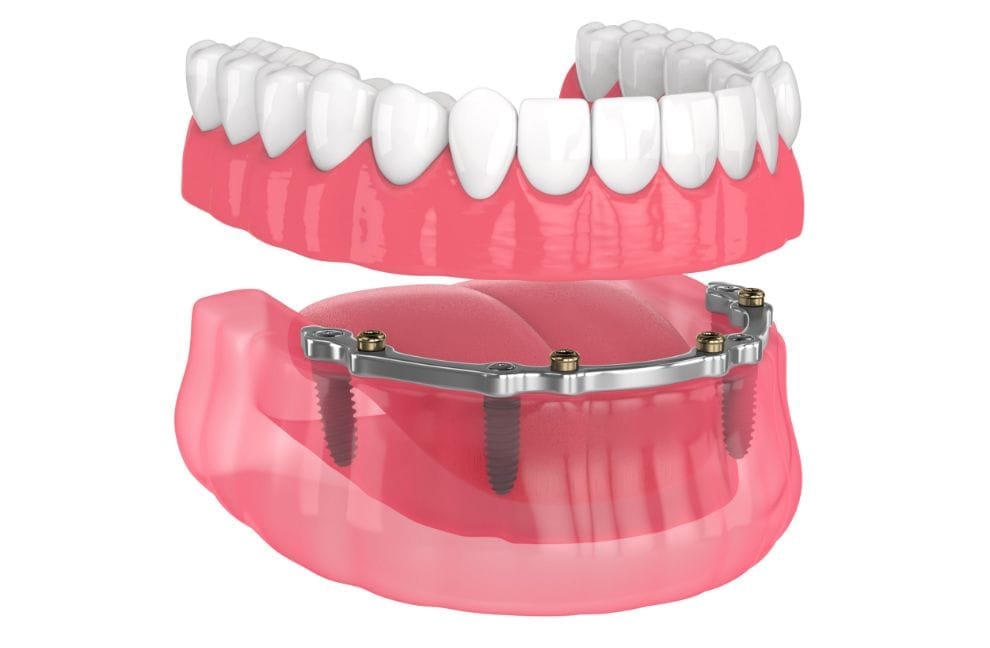
Dental implantology is the set of surgical techniques that aim to rehabilitate a patient’s masticatory function, using dental implants, i.e. artificial pillars which, once integrated into the bone, will be able to support one or more artificial teeth.
The dental implant replaces and totally replaces the lost tooth both from an aesthetic and functional point of view. The total time, in traditional implantology, for implant-prosthetic rehabilitation ranges from 3 months to 6 months, depending on the clinical case.

In this type of implant technique, if the clinical case allows it, it is possible to extract the compromised dental elements and simultaneously insert the corresponding dental implant.
This reduces the number of surgeries required and therefore also the number of medications taken by the patient and also halves the time to finalize the treatment plan.
Of course, together with a post-extractive dental implantology, the immediate loading implantology technique can also be combined.
In the case of post-extractive implantology, if the clinical case allows it, it is possible to extract the compromised dental elements and simultaneously insert the corresponding dental implant.
In a single intervetion, therefore, the extraction is carried out and the dental implant is placed. In this way it will not be necessary to carry out two different interventions.
The main moments of the post-extraction implant insertion technique are:
STEP 1: Tooth extraction, paying attention to leave the alveolus intact.
STEP 2: Cleaning of the alveolus and preparation for implant insertion
STEP 3: Implant insertion.
The success rate of post-extraction implantology is equal to that of traditional implantology.
We have specialized, for some time now, in the creation of dental implants in Milan, with the immediate loading technique. This technique allows us to insert titanium pins and, during the same session, place a semi-permanent fixed prosthesis (temporary, in resin). In this way, the patient will not have to face the long period that lies between the implanted graft and the placement of the crown.
The implant, or implants, are positioned in the morning, and in the afternoon a temporary fixed prosthesis will be screwed into the patient’s mouth.
For immediate loading to be performed, certain conditions are necessary. Among these: sufficient torque (physical resistance to the screwing of the implant, measured with a torque wrench) of at least 35 NW; adequate bone density which will be assessed with a Cone Bean CT scan present in our clinic.
Thanks to the computer planning of the entire operation, computer-assisted implantology allows you to drill the gum and the bone without opening any flap.
An effective treatment option, specifically indicated in patients with bone, jaw, and mandibular atrophy. Replaces missing teeth with a complete restoration that is fixed with only four dental implants, two straight central and parallel ones, and two more inclined outer ones. This solution makes treatment simpler and reduces the need for more invasive procedures, such as those to increase bone volume.
Advantages:
Obtaining a fixed full-arch prosthesis on the day of the surgical intervention quickly leads to an improvement in patient satisfaction in terms of functionality, aesthetics, perception, phonation, and self-esteem.
The inclination of the posterior implants avoids the need for long procedures for bone grafting, while immediate loading abbreviates the treatment times.
The concept is less expensive than the conventional treatment modes of edentulous and near-edentulous arches.

Mainly developed for the upper arch, the All-On-Six technique involves the placement of six implants, two of which are angled (the outer ones) to avoid invasion of the maxillary sinuses. This allows the implants to be immediately loaded with a fixed temporary resin bridge of twelve elements (immediate load).
This procedure can also be computer-planned and performed with guided surgery when conditions permit (computer-guided implantology).

Toronto Bridge refers to a fixed prosthesis screwed onto four or six straight dental implants that can replace up to 12-14 teeth. The main advantages of this technique are many: it is the ideal solution in case of total tooth loss; it is more economical compared to other techniques; the operation can be completed within 12/48 hours; the procedure is minimally invasive and has reduced healing times.

Thanks to the computer planning of the entire procedure, computer-assisted implantology allows for the drilling of the gums and bone without opening any flaps. In other words, the operation does not require cutting of the mucosa to access the underlying bone planes. Therefore, no sutures will be necessary and there will be no swelling or other post-surgical discomforts. The procedure has reduced times compared to the traditional technique. Above all, it allows rehabilitation of patients who, due to systemic diseases (diabetes, coagulopathies, reduction of immune defenses), could not undergo a too-invasive intervention. In the same way, this procedure has proven to be extremely valid in the case of subjects with odontophobia.
What are the benefits?
Also known as transmucosal implantology, the Flapless technique dramatically reduces healing times and is particularly indicated for patients suffering from systemic diseases. During the procedure, holes are made in the gums that have an adequate diameter for implant insertion. This avoids exposing the bone and, therefore, limits the risk of any physiological resorption after surgical exposure. As mentioned, shorter healing times follow.

Overdenture prostheses on bar-anchored implants replace an entire dental arch with a dental prosthesis similar to a removable denture but anchored to a metal bar that is in turn fixed to implants anchored to the mandibular or mandibular or maxillary bone tissue.
Locator attachments offer excellent performance for the application of overdenture on dental implants. Rehabilitation with Overdenture on two dental implants is suitable for edentulous patients.

Do you want to smile again without embarrassment and without thoughts?
Contact us and we will support you in every phase of the rehabilitation of your smile, planning the most suitable intervention for you.
Our dental implant professionals in Milan are at your complete disposal.

There are different types of dental implants and, in particular, different insertion techniques, which are chosen based on the patient’s oral cavity conditions and its bone tissue.
Traditional Dental Implants
Among the most used types of dental implants we find the traditional ones.
Our dental implantology experts in Milan will plan the intervention in detail, precisely designing the site for inserting the implants.
After the operation it will be necessary to wait a few weeks or months before applying the fixed prosthesis, to allow the device to integrate perfectly into the bone and be stable enough to support the artificial tooth.
Transnasal implant
In some cases of bone atrophy we can use this technique, which allows us, through the bone walls of the nasal cavities, without damaging the nasal membrane, to obtain stable and solid implant pillars for the realization of an immediate load.
Trans-nasal implant (bone-less dental implant)
Obtaining bone-less dental implants thanks to trans-nasal implants: they are one of the alternative solutions to additive surgery.
This type of implantology exploits the bone of the mesial wall of the maxillary sinus, anchoring the immediate load implants to it: therefore, the trans-nasal implants are inserted between the maxillary sinus and the paranasal sinus.
In these cases, trans-nasal implants represent a valid alternative to additive surgery, as they exploit the available bone in the mesial wall of the maxillary sinus, anchoring directly to it, reducing waiting times for the possibility of immediate loading.
Bone-less dental implant
Is it possible to insert a bone-less dental implant?
In the studio, our team of dental implant experts in Milan uses various techniques to be able to restore the smile of patients who have little bone residue and who would not be eligible for traditional implantology.
Pterygoid implant
Pterygoid implants are longer than normal dental implants, which can reach up to 25mm.
They are inserted into the pterygoid bone, not in the maxillary bone, as in traditional implantology.
This bone is particularly hard and compact and provides high primary stability.
This is an ideal solution for immediate prosthesis loading, a few hours after implant insertion.
Zygomatic implant (bone-less dental implant)
Zygomatic implantology is a surgical technique that allows the restoration of smile functionality and aesthetics, even in cases where there is little bone residue.
The zygomatic implant is longer than traditional ones and is inserted directly into the zygomatic bone.
In eligible cases, a fixed temporary prosthesis with immediate load is applied a few hours later and the patient will immediately enjoy their new smile.
Zirconia implants
Zirconia dental implants are alternative devices to traditional titanium implants, and are extremely biocompatible and non-metallic.
Zirconia is a very resistant ceramic that guarantees a good duration of the dental prosthesis and has a good capacity for osseointegration.
Another point in favor of this type of device is the best aesthetic result, because it avoids the formation of the typical dark halo around the gums.
Mini implants
Mini dental implants are titanium devices with a smaller diameter than traditional implants.
This type of implant is used for fixing removable prostheses, but also for patients with little remaining bone.
Among the main advantages of mini implants we find: less invasiveness, possibility of immediate loading, shorter post-surgery recovery times.
Traditional Dental Implants
Among the most used types of dental implants we find the traditional ones.
Our dental implantology experts in Milan will plan the intervention in detail, precisely designing the site for inserting the implants.
After the operation it will be necessary to wait a few weeks or months before applying the fixed prosthesis, to allow the device to integrate perfectly into the bone and be stable enough to support the artificial tooth.
Transnasal implant
In some cases of bone atrophy we can use this technique, which allows us, through the bone walls of the nasal cavities, without damaging the nasal membrane, to obtain stable and solid implant pillars for the realization of an immediate load.
Trans-nasal implant (bone-less dental implant)
Obtaining bone-less dental implants thanks to trans-nasal implants: they are one of the alternative solutions to additive surgery.
This type of implantology exploits the bone of the mesial wall of the maxillary sinus, anchoring the immediate load implants to it: therefore, the trans-nasal implants are inserted between the maxillary sinus and the paranasal sinus.
In these cases, trans-nasal implants represent a valid alternative to additive surgery, as they exploit the available bone in the mesial wall of the maxillary sinus, anchoring directly to it, reducing waiting times for the possibility of immediate loading.
Bone-less dental implant
Is it possible to insert a bone-less dental implant?
In the studio, our team of dental implant experts in Milan uses various techniques to be able to restore the smile of patients who have little bone residue and who would not be eligible for traditional implantology.
Pterygoid implant
Pterygoid implants are longer than normal dental implants, which can reach up to 25mm.
They are inserted into the pterygoid bone, not in the maxillary bone, as in traditional implantology.
This bone is particularly hard and compact and provides high primary stability.
This is an ideal solution for immediate prosthesis loading, a few hours after implant insertion.
Zygomatic implant (bone-less dental implant)
Zygomatic implantology is a surgical technique that allows the restoration of smile functionality and aesthetics, even in cases where there is little bone residue.
The zygomatic implant is longer than traditional ones and is inserted directly into the zygomatic bone.
In eligible cases, a fixed temporary prosthesis with immediate load is applied a few hours later and the patient will immediately enjoy their new smile.
Zirconia implants
Zirconia dental implants are alternative devices to traditional titanium implants, and are extremely biocompatible and non-metallic.
Zirconia is a very resistant ceramic that guarantees a good duration of the dental prosthesis and has a good capacity for osseointegration.
Another point in favor of this type of device is the best aesthetic result, because it avoids the formation of the typical dark halo around the gums.
Mini implants
Mini dental implants are titanium devices with a smaller diameter than traditional implants.
This type of implant is used for fixing removable prostheses, but also for patients with little remaining bone.
Among the main advantages of mini implants we find: less invasiveness, possibility of immediate loading, shorter post-surgery recovery times.
In our studio you will find support for any dental problem of your smile.
Our goal is to offer each patient a complete service that is attentive to their specific needs.
Click here to download our e-book on Conscious Sedation
We thank you for your attention!